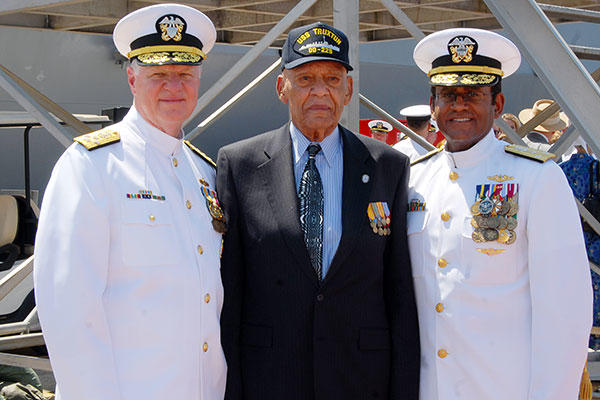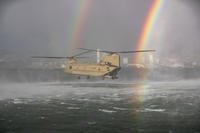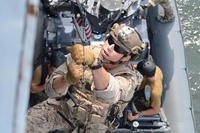Nearly three weeks ago, I sat down to write a column about Black History Month. As an old retired seadog, it seemed fitting for me to concentrate on the history of African Americans in the United States Navy. I felt pretty confident in my overall knowledge of the subject, but I checked out a stack of books from the Public Library and did a little digging just to make sure I had my ducks all lined up properly.
As usual, the research paid off. There was a lot that I didn't know about the history of African Americans in the Navy, and now I'm smart enough to realize there's a lot more that I still don't know. But I accumulated more than enough information to write a column on the subject, and I managed to rough out an outline in a couple of days. From there, it should have been just a matter of elaborating and wordsmithing: a few hours work, and my column would have been ready for prime time.
Three weeks later, I am just finishing my column. I didn't get lazy, and I didn't lose interest. I could plead the pressures of schedule, as the last few weeks truly have been crazy. But it wasn't lack of time that put the brakes on my column. Something happened to me. I discovered Lanier Phillips.
For those of you who already know about Lanier, I'm not claiming that I saw him first, merely that I've only just learned of his existence. If you haven't yet heard of Mr. Phillips, don't be discouraged. His name isn't a household word yet, although it probably should be.
I came across Lanier's name in the course of my research. As a Sonar Technician myself, I wanted to find out about the first African American Sonar Technician in the U.S. Navy. His name, I learned, was Lanier Phillips. (For those who are gearing up to send me emails about Norberto Collado, allow me to point out that Mr. Collado is Cuban, not American. Although he received some training from U.S. Officers, he served aboard Cuban ships, in the navy of his own country. From what I've learned of him, Norberto Collado has an interesting story of his own. But that's for another day, and - more than likely - another columnist.)
I found a few articles on Lanier Phillips, but nothing with any real depth. Then I learned that he lives in Washington, D.C., and - with a few judicious emails - I managed to wrangle a telephone interview. Before I even picked up the phone, I typed up an entire list of cross-referenced questions, sharpened my pencil, and surrounded myself with notes and references about the man's life. I was prepared for the sort of professional no-nonsense interview made famous by the big-named journalists. When the call went through, I even remembered to ask his permission to record our conversation, in case my notes failed to capture something important.
Then Lanier began to speak, and my pretense of professionalism went out the window. I was enthralled. I wasn't struck dumb, mind you. I got in more than my share of talking. But the man is a wonderful storyteller and he has such an incredible story to tell.
Lanier was born in Lithonia, Georgia, in 1923. In the early decades of the twentieth century, De Kalb County was Ku Klux Klan country, and the Klan ruled Lanier's home town. There was only one school for black children, and in 1929, the Klan burned it down. Like every other African American in Lithonia, Lanier lived in constant fear. He dreamed of a different and better life, but what else was there?
In October of 1941, at the age of eighteen, Lanier joined the Navy. As he puts it, "I didn't want to be a sharecropper and the Navy was the only other choice I could see."
In 1941 the only rating open to African American Sailors was Messman, sometimes called Steward's Mate. Messmen cleaned, served, shined the shoes of the officers, and generally performed tasks that were considered too menial for white Sailors. The Navy was still strictly segregated. Blacks and whites had separate berthing compartments, separate heads (bathroom facilities); they even ate separately. White enlisted Sailors took their meals on the mess decks. White Officers ate in the wardroom. Black Sailors had to eat standing up in the Messman's pantry.
In the Navy, Lanier found himself facing a different breed of discrimination. "It wasn't quite like jumping from the frying pan into the fire," he told me with a chuckle. "It was more like jumping from the frying pan into the kettle. It wasn't quite so hot, but it was pretty close."
The Navy didn't go in for whippings or burning crosses, so it was better than the Klan. But not a lot better. It wasn't really safer either. In the Navy, the Klan couldn't grab a man out of his own house in the dark of night, the way they could back in De Kalb County. But, as Lanier would be quick to remind you, Nazi U-boats were already torpedoing ships off the East Coast of the United States. American Sailors were fighting and dying in the Atlantic long before war was declared in December of '41.
Lanier was stationed aboard USS Truxton (DD-229), a destroyer home ported in Boston. The Truxton was assigned to escort duty, protecting convoys of merchant ships from U-boats.
In February of 1942, the Truxton and two other Navy ships ran aground in one of the worst recorded storms in the history of the North Atlantic. The flagship, USS Wilkes, was re-floated within three hours, but the Truxton and Pollux were pounded against the rocks until both ships broke up and sank.
As Lanier spoke to me about the disaster, his normally playful voice grew quiet and solemn. His smooth speech mannerisms became halting and a bit disjointed.
"We were about two-hundred yards from shore," he said. "The waves would pick the ship up and slam it down into the rocks. It just broke in two, like you would take a pencil and snap it in half. Crude oil was everywhere. Everybody was covered in oil. It was twenty below zero, and the oil just jelled. It was like tar.
"My boss, Third Class Henry Langston, was from Truxton, Virginia: right outside of Portsmouth. And Houston, he was from New York. Billy Gene Turner was from Pine Bluff, Arkansas. And we had one Filipino, Tom Dayo. They all died.
"We thought we were in Iceland, you see? The storm had blown us everywhere. We had no way of knowing where we were, so we thought we were in Iceland. And my friends said they'd probably lynch us if we went ashore. Negroes...that's what they called us back then...were not allowed to set foot in Iceland.
"I got on the last raft. The other Stewards wouldn't come. By that time, about half of the crew had been washed overboard. But the other black Sailors said, 'why try to make it? We'll wait till the Navy gets here.' By then, the planes were starting to fly over. But none of the other Steward's Mates made it ashore. They didn't get rescued. The ship just broke apart, and they died."
In all, 110 Truxton Sailors were drowned, frozen to death, or battered to death by the rocks. Ninety-three Sailors from the Pollux died as well.
Of the 46 Sailors who escaped the sinking of the Truxton, 45 were white. Lanier Phillips was the only African American survivor. The other black and Filipino Sailors remained aboard the ship as it was torn apart on the rocks, more willing to take their chances with the sea than with the lynch mobs they expected to find ashore.
The Sailors who did make it to shore found themselves at the foot of a three hundred foot tall cliff, covered in ice. Sick from oil and swallowed seawater, most of them were too exhausted, too battered, and too frozen to even think about such a climb.
Seaman Second Class Edward Bergeron still had a bit of life in him, and he had a knife. He cut handholds into the ice, and managed to drag himself to the top of the cliff. When he reached the top, he spotted lights in the distance, and went for help. The local citizens brought ropes and slings, and made trips up and down the cliffs until every surviving Sailor had been rescued.
Lanier had lost consciousness at the bottom of the cliffs. He woke to find himself lying on a table in an unfamiliar building, under the care of several white women. Other Sailors lay on nearby tables, also under the care of local women. The ladies were washing the Sailors with warm water, trying to pull them back from hypothermia, and also to wash the tar-like crude oil from their bodies.
Lanier quickly realized that he was naked. His mind flew into panic mode. He was a black man ashore in Iceland. That alone might be enough to get him lynched. To make matters worse, he was naked in the presence of white women, and they were touching his body. That had to be enough to get him killed.
The only thing hiding the color of his skin was the crude oil that coated his body. For the moment, every one of the rescued Sailors were black. But, when the oil was washed off, the rest of the survivors would be white. Lanier would still be black. And then things were going to get ugly.
One of his caretakers kept scrubbing the same spot over and over again. "This poor boy," she said. "The oil has gotten into his pores. It just won't come off."
Lanier decided that the sooner the truth came out, the less trouble he would be in. "Ma'am, that's not going to come off," he said. "That's the color of my skin."
And it was out in the open. He was a naked black man in Iceland. His situation could hardly be more damning.
But Lanier was not in Iceland. The storm that had wrecked his ship had pushed them far off course. This was not Iceland at all, but St. Lawrence, Newfoundland.
The lynching that Lanier was expecting never materialized. Quite the contrary. The color of his skin didn't seem to matter to the people of St. Lawrence. They lavished Lanier with every bit of the dignity, respect, and tenderness that they showed the other Sailors. A local family took him into their home and cared for him through the night.
As he lay under the blankets of an unfamiliar bed in the home of a white family, Lanier began to reevaluate his personal worth. His entire life, he had been raised to believe that the color of his skin made him somehow inferior to white people. He had been kicked, abused, threatened, and belittled. Even the Navy, his chosen service, reminded him constantly that he was of less importance than his white shipmates. And now, here was a white family - an entire white community - treating him as though the color of his skin didn't matter at all.
Lanier has said a thousand times since that his brief encounter with the people of St. Lawrence was a life changing experience. Before that freezing February night in 1942, he had accepted racial discrimination as an inevitable fact of life. He certainly hadn't wanted it or liked it, but he had accepted it. Things had always been that way. How could they be different?
He wasn't the same man after St. Lawrence. He had seen life as it could be: life as it should be. He knew that he was worthy of fair treatment and respect. He knew that a society could exist in which the color of a person's skin was irrelevant. He had seen that society, walked its streets, and been invited into its homes.
When teams of Sailors came through St. Lawrence the next day to round up the survivors of the shipwreck, Lanier realized that he was going back to the same sort of treatment that he had left behind, in both the Navy and in his own country.
Two years after the sinking of the Truxton, he was transferred to Jacksonville, Florida. When his train arrived in Jacksonville, he searched the train station for a place where a black man could buy a meal. The usual 'Colored Only' signs seemed to be missing, so he asked a Military Policeman for directions. The MP didn't know, but he directed Lanier to a hall where German and Italian prisoners of war were eating lunch, and advised him to ask one of the guards.
As soon as Lanier stepped into the hall, he was seized by a Jacksonville Policeman, and shoved to the ground. The Policeman put a boot on Lanier's neck, and threatened to shoot him in the head for daring to set foot in a room where white men were eating. Lanier was in uniform at the time. While captured enemies were treated with dignity and respect, this American serviceman in the uniform of his country lay on the ground at gunpoint, enduring threats and racial insults. Lanier's only defense was to think back to St. Lawrence, and to remind himself that he deserved better.
He continued to do his job and to endure.
In the late nineteen-fifties, after 17 years of shining shoes and washing dishes, he had another life-altering realization. The status quo would never change unless somebody changed it. Lanier recognized that he needed to do his part to bring that transformation about. He wrote a letter to the first African American Congressman, as well as the Bureau of Naval Personnel, informing them that he was qualified to be more than a Mess Attendant. He requested a technical school: any technical school.
It was an extremely courageous thing to do. Back then, minorities didn't dare question Navy policy. They didn't petition senior Navy leadership for redress of wrongs, or even suggest that they should receive the same treatment or benefits as white Sailors. Lanier's letter to the Bureau of Naval Personnel could have brought him all manner of grief. Instead, a few months later, it brought him new orders. He was to report to Fleet Sonar School in Key West, Florida, for training as a Sonar Technician.
If Lanier thought his troubles were over, he was mistaken. When he arrived at Fleet Sonar School, he ran into another barrier. To qualify for Sonar training, he needed a security clearance. Before granting a clearance, government investigators were required to locate and examine records regarding an applicant's parents and grandparents, to verify a Sailor's citizenship and identity, and to cross-check for disqualifying criminal activity. For most students, the process was quick and routine. For an African American, it was a problem. Many counties and states didn't begin maintaining records for African Americans until well into the twentieth-century. There were few, if any, records for Lanier's family. Government investigators could not find the information they needed to certify Lanier's clearance.
And so he waited, for days, weeks, and then months, while the system tried to cope with a situation it had never been designed to handle. After all, who could have imagined that a black man would ever need a Security Clearance?
While Lanier waited for news of his clearance, the Sonar School Counselor tried chipping away at his willpower. "You're too old to learn something this technical," the man told him. "The rest of the students are young, and their minds are sharp. You won't be able to keep up. They're all better educated than you are." That much was certainly true. Many of the white students had college; Lanier was almost entirely self-educated.
When everything else failed to discourage Lanier, the Counselor resorted to bribery. He offered Lanier a promotion to Chief Steward's Mate. He even promised to backdate the promotion to the previous October, which would entitle Lanier to nearly a year's worth of back-pay at a Chief Petty Officer's salary. To a black man in the 1950's, it was a veritable fortune. The money and promotion were his for the taking. All he had to do was drop out of the Sonar program.
Lanier looked the Counselor in the eye and said, "Sir, if you want me out of Sonar School, you're going to have to throw me out. Because I am not leaving otherwise."
Against all odds, Lanier's clearance was finally approved. He was admitted into Sonar School.
Many of the Counselor's words proved to be true. The other students were younger and better educated. They also had the benefits of solidarity and camaraderie.
Lanier's companions were isolation and discrimination. But he had a secret weapon. "I studied harder than everyone else in that school," he told me. "Those other boys were there for themselves. If one of them flunked out, it was his problem and his alone. But I had the future of black Sailors to think about. If I didn't make it, the next black man would have it ten times as hard."
Another man in his situation might have become bitter and disillusioned. Lanier buckled down and worked harder, determined to prove that a black man could excel in a technical rating. His hard work paid off. In 1957, he became the first African American Sonar Technician in the United States Navy.
Following Sonar School, he reported to a destroyer, USS Bailey (DD-713). When he arrived on the quarterdeck, the Officer of the Deck tried to send him down to the Steward's berthing, with the rest of the black Sailors. Lanier shook his head, presented his written orders, and said proudly, "No Sir! I'm not a Steward's Mate. I'm your new Sonar Technician."
Lanier went on to tell me at length about some of the things he did afterward to demonstrate his technical abilities to a disbelieving Navy. I'd love to print them all here, but this column has already grown too long. Let me just say that the Navy did begin to change, and the Lanier Phillips was one of the catalysts. He didn't restrict his efforts to the Navy, either. In 1965, four years after his retirement from the Navy, he marched with Dr. Martin Luther King Jr. at Selma, Alabama. As a civilian technician, Lanier went on to work with EG&G and the ALVIN deep water submersible team, demonstrating time and again that an African American man can function at the absolute pinnacle of technical excellence.
Lanier is incredibly proud of today's Navy. He holds the Navy up as a model of what Equal Opportunity should look like. He's pleased to have had a hand in bringing it about. And, as he told me near the end of our interview, "That's not too bad for a guy who started out shining shoes."
Related video:
Related links:














